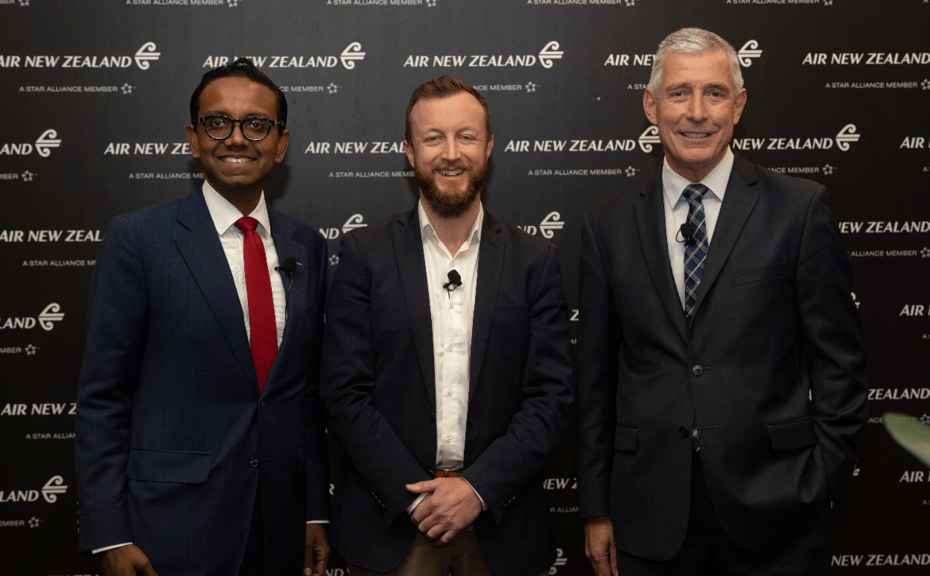Air New Zealand launches ambitious programme for zero emissions aircraft
Today, Air New Zealand has announced Mission Next Generation Aircraft – an accelerator programme to progress two ambitious goals:
- Fly its first commercial demonstrator flight from 2026
- Begin replacing its Q300 domestic fleet with a more sustainable aircraft – likely green hydrogen or battery hybrid systems – from 2030
These goals follow the airline's Product Requirements Document (PRD) released in December 2021, which saw more than 30 aircraft developers respond with ideas and insights to guide the technology development. Air New Zealand is in close negotiations and expects to sign letters of intent by the end of the year with the partners it will work with.
Air New Zealand Chief Executive Officer Greg Foran says Air New Zealand aims to lead the world in introducing a more sustainable fleet.
"We have bold sustainability goals. Conventional business processes are not going to address the technology or infrastructure required to meet them. We want to lead the roll out of zero emission aircraft and will work alongside aircraft developers, innovators and infrastructure providers to give them the confidence they're developing a product that's a viable option for us.
"The next three years will be focused on supporting the building, testing and certifying of aircraft and associated infrastructure. By 2026, we're aiming to have our first zero emissions aircraft – either cargo or passenger – take flight in New Zealand.
"The learnings we will take from flying an aircraft with next generation propulsion technology from 2026 will pave the way for our long-term green hydrogen and hybrid partners to deliver an aircraft that can replace our Q300 domestic fleet. We're breaking new ground here – it's not just the aircraft that needs to be developed, but also the infrastructure and regulation required to fly commercially."
"We know these goals are ambitious, but ambition is exactly what is required to make this new technology a reality."
The PRD process highlighted how New Zealand, and Air New Zealand, are ideally suited to lead the development of zero emissions aircraft deployment and the establishment of supporting infrastructure.
"We mainly operate short-range routes up and down the country, and New Zealand is largely built on renewable electricity generation – it's an ideal landscape to adopt zero emission aircraft.
"But we can't do it alone. It will take the minds of many within the industry to find the right solution. The technology is getting there, it just needs to be developed to a scale we can roll out across our network. It's a wicked problem to solve but we're two feet in."
While zero emissions aircraft technology will decarbonise the airline's domestic network over the period to 2050, Sustainable Aviation Fuel (SAF) is important in the near term.
SAF is a 'drop in' fuel which can power current aircraft, so it can reduce emissions for long haul travel and domestic flights while the airline continues to operate conventional aircraft.
Ends

To download Mission Next Generation Aircraft video, click here, and for an image, click here.
To download b-roll from today's announcement, click here.
Issued by Air New Zealand Communications
Email: media@airnz.co.nz │Phone: +64 21 747 320│Twitter: @AirNZMedia
About Air New Zealand
Air New Zealand's story started in 1940, first taking to the skies between Auckland and Sydney on a flying boat - a Short S30. Known for its warm Kiwi hospitality, today, the airline has 98 operating aircraft ranging from Boeing 787-9 Dreamliners and Airbus A320s to ATRs and Q300s, offering customers comfort in the latest most efficient jets and turboprops. It's a modern fuel-efficient fleet with an average age of 6.7 years. Air New Zealand's global network of passenger and cargo services centres around New Zealand. Pre-Covid, the airline flew more than 17 million passengers every year, with 3,400 flights per week. Air New Zealand was recently named the World's Safest Airline by the Australian rating service AirlineRatings.com, highlighting the airline's laser-focus on safety. This year, Air New Zealand won Best Corporate Reputation in New Zealand – 8th year in a row.
Air New Zealand has a well-connected domestic business, connecting customers and cargo to 20 different regions around New Zealand. Internationally, the airline has direct flights to major cities across Australia, Asia, the Pacific Islands and the US, and through its strong relationships with alliance partners, offers customers more choice and convenience to connect further afield to hundreds of destinations. Air New Zealand has a particular focus on sustainability and its Sustainability Framework helps guide the airline's efforts in tackling some of New Zealand's and the world's most complex challenges. Airpoints, Air New Zealand's loyalty programme, is seen as the most valuable loyalty programme in New Zealand with 3.5 million members. It allows members to earn Airpoints Dollars™ and Status Points for VIP benefits in the air and on the ground. Air New Zealand aircraft are proudly identified by its distinct tail livery of the Mangōpare, the Māori symbol of the hammerhead shark which represents strength, tenacity, and resilience.
About Star Alliance
Air New Zealand is proud to be a member of Star Alliance. The Star Alliance network was established in 1997 as the first truly global airline alliance to offer worldwide reach, recognition and seamless service to the international traveller. Its acceptance by the market has been recognized by numerous awards, including the Air Transport World Market Leadership Award and Best Airline Alliance by both Business Traveller Magazine and Skytrax. The member airlines are: Aegean Airlines, Air Canada, Air China, Air India, Air New Zealand, ANA, Asiana Airlines, Austrian, Avianca, Brussels Airlines, Copa Airlines, Croatia Airlines, EGYPTAIR, Ethiopian Airlines, EVA Air, LOT Polish Airlines, Lufthansa, Scandinavian Airlines, Shenzhen Airlines, Singapore Airlines, South African Airways, SWISS, TAP Portugal, Turkish Airlines, THAI and United. Overall, the Star Alliance network currently offers more than 18,500 daily flights to 1,321 airports in 193 countries.